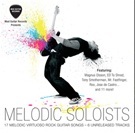All About Scales On Guitar
 Somewhere along the way in our development as guitar players, we start to get the idea that it would be a good idea if we learned some of those things called scales.If we are new to the guitar, and new to music, we are probably not even quite sure exactly what a scale actually is, which certainly adds to the aura of mystery that begins to surround the subject.
Somewhere along the way in our development as guitar players, we start to get the idea that it would be a good idea if we learned some of those things called scales.If we are new to the guitar, and new to music, we are probably not even quite sure exactly what a scale actually is, which certainly adds to the aura of mystery that begins to surround the subject.
The next thing that happens, as we continue along in our development, is that we begin to get the unsettling impression that there seems to be an awful lot of those things called scales!
In fact, there seems to be hundreds of them. We may even run across an encyclopedia of scales, and realize that there could be thousands of these little buggers out there! The very prospect of learning all those scales begins to make us weak in the knuckles!
It is at about this point that we start to get a little suspicious, a little curious about this whole business of scales and what they really have to do with us, and what we want to do on the guitar. “How many of these things do I have to learn, anyway”?, we ask, “and what do I do with them once I learn them”?
Then we go and try to find the answer to our questions. We read magazines and hear a lot of advanced and professional guitarists talk on the subject, and it leaves us even more confused. One guy says we must know a hundred ways to play a major scale, and then we should learn a hundred minor scales, and then start on the more exotic type of scales. Another guy, who is also an advanced player, perhaps professional and perhaps rich and famous, says he only uses a few scales. So after all our agonized searching, we are even more confused than when we started!
What gives?
Well, I am going to try and provide some clarity on the subject. I am going to lay out an overall view of the subject, and provide you with an understanding of what scales are, what they are used for, and how the way scales are used is DIFFERENT for different types of players. Once you understand these things, you will be in a much better position to achieve some clarity on the subject, and make your own decisions about how you are going to include the study of scales into your practice regimen.
What Scales Are, Musically, and Why We Practice Them
Musically speaking, a scale is simply a series of notes, following one after the other. The really important thing about any scale is the SPACE between the notes, and by space, I mean the space in terms of PITCH. It is the distance in pitch between two notes that contains the EMOTIONAL CONTENT of music. This is one of the most important concepts that any musician can know, and most do know it, if only on an intuitive level. For those wishing to develop an understanding of music theory, this concept should be pursued and understood. I cannot go into it in the depth it deserves in this essay, but I will lay out the essence of it, and you should pursue it with your teacher, and in books.
If I play a note on the guitar, and then play the same note again, there is no distance in pitch between the two notes. If I play a note, and then play the note on the very next fret, the distance in PITCH, (which is the “highness” or “lowness” of a sound), between those two notes is called a half step. If I play a note, and then play the note two frets away (a note on the first fret, then the third), that is called a whole step, and the effect is very different than a half step. If I play a note and then the note three frets away, that distance is called a minor third.
All of these different spacings in pitch between notes are called INTERVALS in music theory. In the interval of a minor third mentioned above, you can really hear what I mean by the “emotional content” of the interval. The minor third interval is contained in the minor chord, and this particular “spacing” between notes is what gives a minor chord it’s dark, minor sound. When you play a blues scale, it is the sound made by the first two notes, and gives the blues scale it’s bluesy feeling (or at least contributes to it, as do some other intervals).
That is as far as I want to go with Intervals for now. I just want you to know they exist, and that they carry the “emotion” of music. I want you to know that every scale not only contains notes, but that the SPACES, or Intervals between the notes are what is really important. Scales come in different “types”, major, minor, diminished, etc. Each type of scale has its own peculiar spacings between the notes, and these spacings give each type of scale its unique emotional feeling or “color”. You will see later that players of different styles use different types of scales in their playing. A lifelong blues/rock player may never need to play a major scale.
Because each type of scale has the same intervals between notes, each type of scale has the same “feeling”, even if it has a different letter name. In other words, if you play a C major scale, or a D major scale, or a G major scale, they will all have the same pattern of spaces, or intervals between each of the notes, as well as each containing the same number of notes, so, they will all sound “the same” in terms of the “emotional content” or feeling of the scale. In fact, you could say they all have the same “color”. Minor scales have a different spacing between the notes than major scales, and it gives them a “dark” color.
Using this analogy, you could think of a scale as a palette of colors. If a composer wants to write a sad piece, he will pull out a minor scale, and use those notes to write it. In this sense, we could say scales are the building blocks of music.
What Scales Are, Technically, And Why We Practice Them
Musically speaking, we have seen that scales are the “building blocks” of music. Many times in playing all types of music, we find ourselves simply playing scales, backwards and forwards, and in lots of other patterns. So it would seem natural that it would be a good idea to know how to play them, and it is!
If we think about scales in terms of technique, in terms of what it takes to actually play them on the guitar, we realize that simply because a scale is a string of notes, the simple act of playing a scale is quite a demand on the player. And the faster the scale, the greater the demand. In fact, for guitar players, scales are a whole lot more difficult than they are for most other musicians. A piano player only needs one finger to play one note, but a guitar player needs the co-ordinated action of TWO fingers (or finger and pick) to produce one note, and that has profound implications. As a guitar player, you would be wise to reflect on and appreciate this fact.
Almost all guitar students are unprepared for effective scale practice when the first scale comes along. The concept of truly independent finger action must have already begun to become a physical reality in the hands in order for scales to begin to be practiced with benefit, and not harm.
Segovia wrote, in his famous collection of scales for the classical guitarist “the study of scales will solve a greater number of technical problems in a shorter amount of time than the study of any other technical exercise.” In other words, if you are able to successfully play scales, and get one finger after another to do what it needs to do to get those notes, then there are a whole lot of other things you will also be able to do. So this means that the study of scales is one of the best things we can do in our practice sessions to develop and maintain our technique.
And this is one of the main points I want to get across here: scales are, at the very least, a primary technical exercise for all types of guitarists. For non-improvising guitarists such as classical guitarists, this is, in fact, their main purpose. A classical guitarist does not need a million scales at his fingertips. Since scales are serving only the purpose of providing excellent exercise for the fingers, we only need to select and practice the ones we feel give us that exercise. In fact, in Segovia’s collection, most of the scales are simply the same finger patterns moved around the neck.
Of course, there is a world of things to know about the CORRECT way to practice scales so that our fingers actually do learn to play them well, and so that the practice of scales helps us technically, rather than hurts us. For far too many students, scale practice gets them nowhere, and in fact, only builds crippling tension into the fingers.
This is because there are fundamental finger movements that must learned, and learned well, before any type of scale can or should be practiced. I have covered these essential finger fundamentals extensively in “The Principles Of Correct Practice For Guitar” , which is the starting point for anyone who wants to build a fully functioning left hand on guitar. Practicing scales successfully is a complex matter, not to be underestimated, and not to be undertaken without a lot of effort to understand HOW to practice them correctly. “The Principle” will give you the understanding and the method you need.
With this is mind, we could interpret Segovia’s statement to mean “if you can figure out how to learn scales well, you can figure out a lot of other technical challenges that playing the guitar poses”.
What Scales Should You Know? How scales are used musically by Guitarists
As you probably suspect by now, exactly what scales, and how many scales a player should know, depends on the style that player is playing. Here are some general guidelines to help you figure out what YOU should be doing about scale practice in your own playing.
* ALL players should learn and practice major scales in the first position in the common keys of C, G, D, A, E, and for the ambitious, the relative minors of these major keys.
* ALL players should learn movable scale patterns. Major scales that begin with the 2nd finger on the 6th string, as well as the pattern that begins with the 2nd finger on the 5th string should be learned. After that, the major scale pattern that begins with the 4th finger should be learned, first from the 6th string, then the 5th.
* Ambitious players should then learn the major scale that starts with the first finger on the 6th and 5th strings. Having these scales in your fingers (six major scales) also puts all the arpeggios and modes into your fingers as well. I have provided comprehensive and note by note instruction on these scales in my course “The 6 Essential Major Scales”.
* For those wishing to play blues and rock, you should learn the first pentatonic scale inside and out, backwards, forwards, and various patterns. There are 5 pentatonic scale positions in all, and you should gradually learn them all. Of course, you must learn the licks that come out of them as well, and how to use them in improvising in the common keys (A & E first). My “Rock & Blues Foundation Course” will give you complete training in how to play, and how to use these scales.
For players wanting to improvise in the more sophisticated styles, such as jazz, or fusion styles, all the above should be learned. After that, you are a prime candidate for one of those gigantic, monster scale books we talked about earlier!
Of course, there is a whole lot more to know about the subject, but I hope I have provided the basis for a little clarity, especially for those new to the instrument. Good luck finding which scales are right for you!
Copyright 2012 Jamie Andreas. All rights reserved. Used by permission.Begin YOUR journey to guitar excellence – find out more about “The Principles Of Correct Practice For Guitar”. Visit www.guitarprinciples.com










